Invertebrate
| Invertebrates Temporal range: Cryogenian to Present,
| |
|---|---|

| |
| Left to right: Tardigrada ).
| |
| Scientific classification | |
| Domain: | Eukaryota |
| (unranked): | Filozoa |
| Kingdom: | Animalia |
| Groups included | |
| |
Invertebrates is an
The majority of animal species are invertebrates; one estimate puts the figure at 97%.[1] Many invertebrate taxa have a greater number and diversity of species than the entire subphylum of Vertebrata.[2] Invertebrates vary widely in size, from 10 μm (0.0004 in)[3] Myxozoans to the 9–10 m (30–33 ft) colossal squid.[4]
Some so-called invertebrates, such as the
Etymology
The word "invertebrate" comes from the Latin word vertebra, which means a joint in general, and sometimes specifically a joint from the spinal column of a vertebrate. The jointed aspect of vertebra is derived from the concept of turning, expressed in the root verto or vorto, to turn.[5] The prefix in- means "not" or "without".[6]
Taxonomic significance
The term invertebrates is not always precise among non-biologists since it does not accurately describe a
Despite this, the concept of invertebrates as a taxon of animals has persisted for over a century among the
.Number of extant species
By far the largest number of described invertebrate species are insects. The following table lists the number of described
| Invertebrate group | Phylum | Image | Estimated number of described species[11] |
|---|---|---|---|
Insects
|
Arthropoda
|
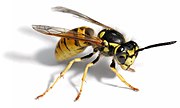
|
1,000,000 |
Arachnids
|
Arthropoda
|
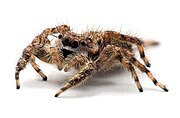
|
102,248 |
| Snails | Mollusca | 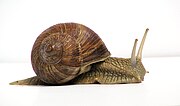
|
85,000 |
Crustaceans
|
Arthropoda
|
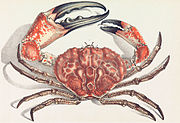
|
47,000 |
| Clams | Mollusca | 
|
20,000 |
| Corals | Cnidaria | 
|
2,175 |
| Octopuses/Squid | Mollusca | 
|
900 |
Velvet worms
|
Onychophora | 
|
165 |
| Nautilus | Mollusca | 
|
6 |
Horseshoe crabs
|
Arthropoda
|

|
4 |
| Others jellyfish, echinoderms, sponges, other worms etc. |
— | — | 68,658 |
| Total: | ~1,300,000 |
The
Characteristics
The trait that is common to all invertebrates is the absence of a
Morphology and symmetry
The
Other examples of asymmetry are found in
Nervous system
Learning and memory using nociceptors in the sea hare, Aplysia has been described.[16][17][18] Mollusk neurons are able to detect increasing pressures and tissue trauma.[19]
Neurons have been identified in a wide range of invertebrate species, including annelids, molluscs, nematodes and arthropods.[20][21]
Respiratory system

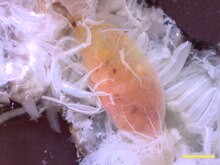
One type of invertebrate respiratory system is the open
A tracheal tube may contain ridge-like circumferential rings of
Hearing
Only vertebrate animals have ears, though many invertebrates detect sound using other kinds of sense organs. In insects, tympanal organs are used to hear distant sounds. They are located either on the head or elsewhere, depending on the insect family.[25] The tympanal organs of some insects are extremely sensitive, offering acute hearing beyond that of most other animals. The female cricket fly Ormia ochracea has tympanal organs on each side of her abdomen. They are connected by a thin bridge of exoskeleton and they function like a tiny pair of eardrums, but, because they are linked, they provide acute directional information. The fly uses her "ears" to detect the call of her host, a male cricket. Depending on where the song of the cricket is coming from, the fly's hearing organs will reverberate at slightly different frequencies. This difference may be as little as 50 billionths of a second, but it is enough to allow the fly to home in directly on a singing male cricket and parasitise it.[26]
Simpler structures allow other arthropods to detect near-field sounds. Spiders and cockroaches, for example, have hairs on their legs, which are used for detecting sound. Caterpillars may also have hairs on their body that perceive vibrations[27] and allow them to respond to sound.Reproduction
Like vertebrates, most invertebrates reproduce at least partly through
Others are capable of asexual reproduction, or sometimes, both methods of reproduction.Extensive research with model invertebrate species such as Drosophila melanogaster and Caenorhabditis elegans has contributed much to our understanding of meiosis and reproduction. However, beyond the few model systems, the modes of reproduction found in invertebrates show incredible diversity.[30] In one extreme example it is estimated that 10% of orbatid mite species have persisted without sexual reproduction and have reproduced asexually for more than 400 million years.[30]
Reproductive systems
Social interaction
Social behavior is widespread in invertebrates, including cockroaches, termites, aphids,
Insects recognize information transmitted by other insects.[32][33][34]
Phyla
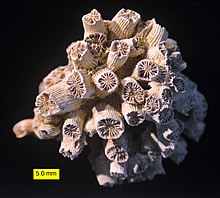
The term invertebrates covers several phyla. One of these are the sponges (
The
The largest animal phylum is also included within invertebrates: the Arthropoda, including insects,
Another phylum is
Also included are two of the most successful animal phyla, the Mollusca and Annelida.[51][52] The former, which is the second-largest animal phylum by number of described species, includes animals such as snails, clams, and squids, and the latter comprises the segmented worms, such as earthworms and leeches. These two groups have long been considered close relatives because of the common presence of trochophore larvae, but the annelids were considered closer to the arthropods because they are both segmented.[53] Now, this is generally considered convergent evolution, owing to many morphological and genetic differences between the two phyla.[54]
Among lesser phyla of invertebrates are the
Classification of invertebrates
Invertebrates can be classified into several main categories, some of which are
- Sponges(Porifera)
- Comb jellies(Ctenophora)
- Medusozoans and corals (Cnidaria)
- Acoels (Xenacoelomorpha)
- Flatworms (Platyhelminthes)
- Bristleworms, earthworms and leeches (Annelida)
- Insects, springtails, crustaceans, myriapods, chelicerates (Arthropoda)
- Chitons, snails, slugs, bivalves, tusk shells, cephalopods (Mollusca)
- Roundworms or threadworms(Nematoda)
- Rotifers(Rotifera)
- Tardigrades(Tardigrada)
- Scalidophores (Scalidophora)
- Lophophorates (Lophophorata)
- Velvet worms(Onychophora)
- Arrow worms(Chaetognatha)
- Gordian worms or horsehair worms(Nematomorpha)
- Ribbon worms (Nemertea)
- Placozoa
- Loricifera
- Starfishes, sea urchins, sea cucumbers, sea lilies and brittle stars (Echinodermata)
- Acorn worms, cephalodiscids and graptolites(Hemichordata)
- Lancelets(Amphioxiformes)
- Salps, pyrosomes, doliolids, larvaceans and sea squirts(Tunicata)
- Cycliophora (currently a monogeneric phylum)
History
The earliest animal fossils appear to be those of invertebrates. 665-million-year-old fossils in the Trezona Formation at Trezona Bore, West Central Flinders, South Australia have been interpreted as being early sponges.
Around 453 MYA, animals began diversifying, and many of the important groups of invertebrates diverged from one another. Fossils of invertebrates are found in various types of sediment from the Phanerozoic.[60] Fossils of invertebrates are commonly used in stratigraphy.[61]
Classification
Significance of the group
Invertebrates are animals without a vertebral column. This has led to the conclusion that invertebrates are a group that deviates from the normal, vertebrates. This has been said to be because researchers in the past, such as Lamarck, viewed vertebrates as a "standard": in Lamarck's theory of evolution, he believed that characteristics acquired through the evolutionary process involved not only survival, but also progression toward a "higher form", to which humans and vertebrates were closer than invertebrates were. Although goal-directed evolution has been abandoned, the distinction of invertebrates and vertebrates persists to this day, even though the grouping has been noted to be "hardly natural or even very sharp." Another reason cited for this continued distinction is that Lamarck created a precedent through his classifications which is now difficult to escape from. It is also possible that some humans believe that, they themselves being vertebrates, the group deserves more attention than invertebrates.[62] In any event, in the 1968 edition of Invertebrate Zoology, it is noted that "division of the Animal Kingdom into vertebrates and invertebrates is artificial and reflects human bias in favor of man's own relatives." The book also points out that the group lumps a vast number of species together, so that no one characteristic describes all invertebrates. In addition, some species included are only remotely related to one another, with some more related to vertebrates than other invertebrates (see Paraphyly).[63]
In research
For many centuries, invertebrates were neglected by biologists, in favor of big vertebrates and "useful" or
Two of the most commonly studied model organisms nowadays are invertebrates: the fruit fly Drosophila melanogaster and the nematode Caenorhabditis elegans. They have long been the most intensively studied model organisms, and were among the first life-forms to be genetically sequenced. This was facilitated by the severely reduced state of their genomes, but many genes, introns, and linkages have been lost. Analysis of the starlet sea anemone genome has emphasised the importance of sponges, placozoans, and choanoflagellates, also being sequenced, in explaining the arrival of 1500 ancestral genes unique to animals.[65] Invertebrates are also used by scientists in the field of aquatic biomonitoring to evaluate the effects of water pollution and climate change.[66]
See also
References
- S2CID 34992724. Archived from the originalon 15 November 2016. Retrieved 17 June 2014.
- ISBN 978-0-412-61390-6.
- PMID 14710996.
- ^ Roper, C.F.E. & P. Jereb (2010). Family Cranchiidae. In: P. Jereb & C.F.E. Roper (eds.) Cephalopods of the world. An annotated and illustrated catalogue of species known to date. Volume 2. Myopsid and Oegopsid Squids. FAO Species Catalogue for Fishery Purposes No. 4, Vol. 2. FAO, Rome. pp. 148–178.
- ^ Tucker, T. G. (1931). A Concise Etymological Dictionary of Latin. Halle (Saale): Max Niemeyer Verlag.
- ^ Skeat, Walter William (1882). An etymological dictionary of the English language. Clarendon Press. p. 301.
- ISBN 978-0-697-13712-8.
- ISBN 978-0-87893-098-2.
- ISBN 978-0-19-861271-1.
- ISBN 978-0-486-15135-9.
- ^ IUCN Red List of Threatened Species, 2014.3. Summary Statistics for Globally Threatened Species. Table 1: Numbers of threatened species by major groups of organisms (1996–2014).
- PMID 21672730.
- The Columbia Electronic Encyclopedia(2007).
- ^ Nicholls, J.G. and Baylor, D.A., (1968). Specific modalities and receptive fields of sensory neurons in CNS of the leech. Journal of Neurophysiology, 31: 740–756
- ^ Pastor, J., Soria, B. and Belmonte, C., (1996). Properties of the nociceptive neurons of the leech segmental ganglion. Journal of Neurophysiology, 75: 2268–2279
- ^ Byrne, J.H., Castellucci, V.F. and Kandel, E.R., (1978). Contribution of individual mechanoreceptor sensory neurons to defensive gill-withdrawal reflex in Aplysia. Journal of Neurophysiology, 41: 418–431
- ^ Castellucci, V., Pinsker, H., Kupfermann, I. and Kandel, E.R., (1970). Neuronal mechanisms of habituation and dishabituation of the gill-withdrawal reflex in Aplysia. Science, 167: 1745–1748
- ^ Fischer, T.M., Jacobson, D.A., Counsell, A.N., et al., (2011). Regulation of low-threshold afferent activity may contribute to short-term habituation in Aplysia californica. Neurobiology of Learning and Memory, 95: 248-259
- ^ Illich, P.A and Walters, E.T., (1997). Mechanosensory neurons innervating Aplysia siphon encode noxious stimuli and display nociceptive sensitization. The Journal of Neuroscience, 17: 459-469
- ^ Eisemann, C.H., Jorgensen, W.K., Merritt, D.J., Rice, M.J., Cribb, B.W., Webb, P.D. and Zalucki, M.P., (1984). "Do insects feel pain? — A biological view". Cellular and Molecular Life Sciences, 40: 1420–1423
- ^ St John Smith, E. and Lewin, G.R., (2009). Nociceptors: a phylogenetic view. Journal of Comparative Physiology A, 195: 1089-1106
- ISBN 0-471-15955-7.
- S2CID 43634044.[permanent dead link]
- PMID 16207077.
- .
- Greenwood Press.
- ^ Scoble, M.J. 1992. The Lepidoptera: Form, function, and diversity. Oxford University Press
- ISBN 978-0-7689-2885-3.
- ISBN 978-1-4051-3277-0.
- ^ a b Picard MAL, Vicoso B, Bertrand S, Escriva H. Diversity of Modes of Reproduction and Sex Determination Systems in Invertebrates, and the Putative Contribution of Genetic Conflict. Genes (Basel). 2021 Jul 27;12(8):1136. doi: 10.3390/genes12081136. PMID 34440310; PMCID: PMC8391622
- ISBN 978-0521589772.
- S2CID 4413962.
- .
- ^ Frisch, Karl von. (1967) The Dance Language and Orientation of Bees. Cambridge, Massachusetts: The Belknap Press of Harvard University Press.
- ISBN 978-81-261-0675-2.
- ISBN 978-0-7637-5730-4.
- ^ Jessop, Nancy Meyer (1970). Biosphere; a study of life. Prentice-Hall. p. 428.
- ISBN 978-81-8293-018-6.
- ^ Dunn et al. 2008. "Broad phylogenomic sampling improves resolution of the animal tree of life". Nature 06614.
- ISBN 978-0-520-22149-9.
- ISBN 978-0-85229-961-6.
- ISBN 978-81-7133-903-7.
- ISBN 978-0-679-77884-4.
- ^ ISBN 978-0-470-75804-5.
- ISBN 978-0-471-20228-8.
- ISBN 978-0-691-05924-2.
- ISBN 978-84-321-3492-0.
- S2CID 6079655.[permanent dead link]
- ^ Todaro, Antonio. "Gastrotricha: Overview". Gastrotricha: World Portal. University of Modena & Reggio Emilia. Retrieved 26 January 2008.
- PMID 21708760.
- ^ "Biodiversity: Mollusca". The Scottish Association for Marine Science. Archived from the original on 8 July 2006. Retrieved 19 November 2007.
- ^ Russell, Bruce J. (Writer), Denning, David (Writer) (2000). Branches on the Tree of Life: Annelids (VHS). BioMEDIA ASSOCIATES.
- JSTOR 2992569.
- ]
- ISBN 978-0-534-40653-0.
- ^ "What Are the Main Groups of Invertebrates?". 4 August 2015.
- doi:10.1038/ngeo934.
- ISBN 978-0-8053-7171-0.
- PMID 9756480.
- ISBN 978-0-632-05238-7.
- ISBN 978-0-405-12715-1.
- ISBN 978-0-632-04761-1.
- OCLC 173898.
- ^ a b c Ducarme, Frédéric (2015). "Why study invertebrates? A philosophical argument from Aristotle". No Bones (Smithsonian Institution website).
- ^
N.H. Putnam, NH; et al. (July 2007). "Sea anemone genome reveals ancestral eumetazoan gene repertoire and genomic organization". S2CID 9868191.
- S2CID 84679634.
Further reading
- Hyman, L. H. 1940. The Invertebrates (6 volumes) New York : McGraw-Hill. A classic work.
- Anderson, D. T. (Ed.). (2001). Invertebrate zoology (2nd ed.). Oxford: Oxford University Press.
- Brusca, R. C., & Brusca, G. J. (2003). Invertebrates (2nd ed.). Sunderland, Mass. : Sinauer Associates.
- Miller, S.A., & Harley, J.P. (1996). Zoology (4th ed.). Boston: WCB/McGraw-Hill.
- Pechenik, Jan A. (2005). Biology of the invertebrates. Boston: McGraw-Hill, Higher Education. pp. 590 pp. ISBN 978-0-07-234899-6.
- Ruppert, E. E., Fox, R. S., & Barnes, R. D. (2004). Invertebrate zoology: a functional evolutionary approach. Belmont, CA: Thomas-Brooks/Cole.
- Adiyodi, K.G. & Adyiodi, R.G. (Eds) 1983- . Reproductive Biology of Invertebrates. Wiley, New York. (Many volumes.)
- Giese, A.G. & Pearse, J.S. (Eds) 1974- . Reproduction of Marine Invertebrates. Academic Press, New York. (Many volumes.)
- Advances in Invertebrate Reproduction. Elsevier Science, Amsterdam. (Five volumes.)
External links
- A. R. Maggenti; S. Gardner (2005). Online Dictionary of Invertebrate Zoology.
- Buglife (UK)
- African Invertebrates
